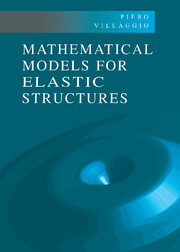Book contents
- Frontmatter
- Contents
- Preface
- Introduction
- Chapter I Basic Concepts
- Chapter II Rod Theories: Three-dimensional Approach
- Chapter III Rod Theories: Director Approach
- Chapter IV Theories of Cables
- Chapter V Theories of Membranes
- Chapter VI Theories of Plates
- Chapter VII Theories of Shells
- References
- Index of Authors Cited
- Index
Chapter III - Rod Theories: Director Approach
Published online by Cambridge University Press: 11 September 2009
- Frontmatter
- Contents
- Preface
- Introduction
- Chapter I Basic Concepts
- Chapter II Rod Theories: Three-dimensional Approach
- Chapter III Rod Theories: Director Approach
- Chapter IV Theories of Cables
- Chapter V Theories of Membranes
- Chapter VI Theories of Plates
- Chapter VII Theories of Shells
- References
- Index of Authors Cited
- Index
Summary
Rods as Oriented Bodies
Rods or, more generally, thin bodies are conceptual abstractions of physical bodies having one or two dimensions much smaller than the third. The prototype of a thin body is a cylinder in which the diameter of the cross-section is much smaller than the length of its generators. If we have to determine the stresses and strains in an elastic cylinder under the action of given loads, the solution of equations of threedimensional elasticity appears as the canonical procedure. Sometimes, however, an alternative method of solution may be suggested by the slenderness of the cylinder. This leads us to attempt a solution which will take the form of a limit of the threedimensional solution when the diameter of the cylinder approaches zero, while the resultant of loads and the global stiffness of the body tend to finite limits. Obviously, the cylinder must not be conceived as a straight line which can only be lengthened, but account must also be taken of the bending and twisting of this line. This is achieved by regarding the cylinder in the limit as a line endowed with directions that may rotate independently of the deformation of the line to which they are attached. The directions, associated with the axis, are called directors and, a material curve, together with a collection of directors assigned to each particle, that is able to deform independently constitutes a Cosserat rod (Cosserat and Cosserat 1907).
In general, the present configuration of a Cosserat rod is specified by a vector function of the variable S (S1≤ S≤S2) and the time t:
This gives the position vectors of a point of a curve in three-dimensional Euclidean space at S, the arc length of the curve. The directors are a set of vectors dk(k= 1,…, K), which are also functions of (S, t).
We require that, under the change of frame
the vector p0 transforms according to the rule
and the directors transform according to the rule
This means that, while p0 behaves like a position vector under a change of frame, the dk terms behave like differences between position vectors.
- Type
- Chapter
- Information
- Mathematical Models for Elastic Structures , pp. 162 - 302Publisher: Cambridge University PressPrint publication year: 1997



